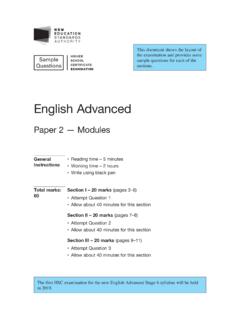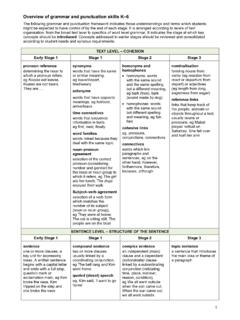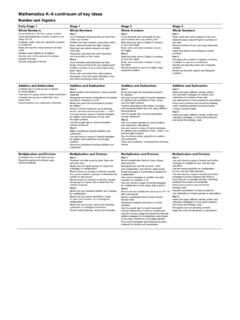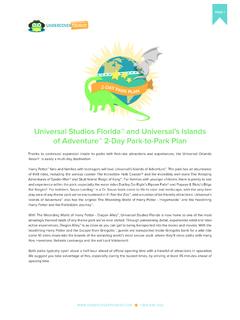Transcription of Suggested texts for the English K–10 Syllabus
1 Suggested texts for the English K 10 SyllabusSUGGESTED texts for the English K 10 Syllabus 2012 Copyright Board of Studies NSW for and on behalf of the Crown in right of the State of New South Wales. This document contains Material prepared by the Board of Studies NSW for and on behalf of the State of New South Wales. The Material is protected by Crown copyright. All rights reserved. No part of the Material may be reproduced in Australia or in any other country by any process, electronic or otherwise, in any material form or transmitted to any other person or stored electronically in any form without the prior written permission of the Board of Studies NSW, except as permitted by the Copyright Act 1968. School students in NSW and teachers in schools in NSW may copy reasonable portions of the Material for the purposes of bona fide research or study. Teachers in schools in NSW may make multiple copies, where appropriate, of sections of the HSC papers for classroom use under the provisions of the school s Copyright Agency Limited (CAL) licence.
2 When you access the Material you agree: to use the Material for information purposes only to reproduce a single copy for personal bona fide study use only and not to reproduce any majorextract or the entire Material without the prior permission of the Board of Studies NSW to acknowledge that the Material is provided by the Board of Studies NSW not to make any charge for providing the Material or any part of the Material to another person or in anyway make commercial use of the Material without the prior written consent of the Board of StudiesNSW and payment of the appropriate copyright fee to include this copyright notice in any copy made not to modify the Material or any part of the Material without the express prior written permission of theBoard of Studies Material may contain third-party copyright materials such as photos, diagrams, quotations, cartoons and artworks. These materials are protected by Australian and international copyright laws and may not be reproduced or transmitted in any format without the copyright owner s specific permission.
3 Unauthorised reproduction, transmission or commercial use of such copyright materials may result in prosecution. The Board of Studies has made all reasonable attempts to locate owners of third-party copyright material and invites anyone from whom permission has not been sought to contact the Copyright Officer, ph (02) 9367 8289, fax (02) 9279 1482. Published by Board of Studies NSW GPO Box 5300 Sydney NSW 2001 Australia Tel: (02) 9367 8111 Fax: (02) 9367 8484 Internet: First published December 2012 Revised February 2013 Revised June 2013 Revised November 2013 Revised December 2017 D2018/127017 D2018/127028 D2017/117964 Contents Part A Syllabus requirements Picture books and graphic Media, multimedia and digital texts ..79 Part B List of texts with Appendix Winners of major book awards for children and young Suggested texts for the English K 10 Syllabus vPreface Suggested texts for the English K 10 Syllabus is a compilation of quality reading and viewing for students in Kindergarten to Year 10.
4 It combines the classics and successful teaching texts with innovative recent works. It includes fiction as well as nonfiction, poetry, drama, film, media and multimedia texts . To reflect the rich diversity of the school population in NSW a range of complexity, themes and cultural orientations is reflected through the lists. This diversity is also evident in the broad scope of the Suggested texts . I would like to acknowledge the support given to the development of Suggested texts for the English K 10 Syllabus by the educators from all teaching sectors who Suggested texts , reviewed the list of texts and provided information about the texts to assist teachers in their use in implementing the new English K 10 Syllabus (2013). I commend Suggested texts for the English K 10 Syllabus to you as a lasting resource for English teachers, parents and students. Tom Alegounarias President Board of Studies PART APART ASYLLABUS REQUIREMENTSS uggested texts for the English K 10 Syllabus 2 Background The texts listed here are suitable for Kindergarten to Year 10 but are not prescribed for study.
5 Predecessors of this list are Works and Plays (Board of Studies 1992), English K 6 Recommended Children s texts (Board of Studies 1995) and Fiction, Film and Other texts : a support document for English Years 7 10 Syllabus (Board of Studies 2003). The present recommended text list owes much to these documents and incorporates many of the texts that were part of Fiction, Film and Other texts (2003) while providing a broader support document for the new English K 10 Syllabus (2013). texts in this document are listed for Kindergarten to Year 10 in the following categories: fiction poetry film nonfiction drama media, multimedia and digital textsText requirements for each stage are found in the Content section of the English K 10 Syllabus , under Content and Text Requirements. The document also refers to links to other lists and sites, including the NSW Premier s Reading Challenge winners of Australian and international book awards for children and young adults.
6 To assist teachers, texts are mapped against the Syllabus requirements. Purposes of the lists The study of a wide range of texts is central to the study of English . Students in each of the stages will read and view a wide range of texts for understanding, critical analysis, interpretation and pleasure that are appropriate to their needs, interests and abilities. These lists include texts that teachers can use to implement the new Syllabus . The choice of texts In choosing the texts listed, the literary merit of the work and the needs, interests and abilities of readers have been balanced with the sensitivities of young and young adult readers. The texts on these lists were selected on the basis of their potential to engage the reader using a number of strategies such as interesting characters, unusual settings and plots, and humour. Some of the texts have layered and multiple meanings, some are provocative; all should help students gain pleasure and power from the exploration of real and imaginary (including virtual) worlds.
7 The inclusion of a text is not a recommendation that it be used in every school setting and context. Schools play an active role is assessing texts to determine their suitability for their purposes and local circumstances. The Syllabus advises that in selecting specific texts for study in English , teachers and schools should consider the needs, Suggested texts for the English K 10 Syllabus 3 interests and abilities of their students as well as the ethos of the school and its local community. texts are identified as suitable for a particular stage; in many cases applicability to multiple stages has been indicated. The same text may be treated differently in each of the identified stages. Identified stages are only suggestions: a text Suggested for Stage 3 may also be appropriate for study in a Stage 5 classroom. None of the lists is exhaustive and each should be regarded as representative of the range and variety of texts to be studied from Kindergarten to Stage 5.
8 The lists are designed to represent not only a range of texts but also of teaching possibilities. The lists attempt to reflect the cultural diversity of contemporary Australia and to give access to translated literature. Classic texts There are specific historical and social circumstances that make any particular generation value a text as a classic, such as the works of dr seuss and the novels, The Wind in the Willows and To Kill a Mockingbird. Schools will want to, and are encouraged to, continue choosing classic texts for study in all years. Specific suggestions for classic texts are included in each section. Some texts on the Suggested lists are already regarded as classics of their genre and many others may well become so. Everyday and workplace texts Students who are studying English in Stages 4 and 5 are required to have experience of everyday and workplace texts . Students in other stages may also want to study these texts .
9 These are texts they will encounter in school, home, work and society and include: spoken, written and visual texts such as:instructions, labels, captions, notices, brochures, catalogues, posters, leaflets,invitations, apologies, complaints, messages, questionnaires, forms, telephoneconversations, postcards, greeting cards, advertising, public addresses, assemblieschecklists, procedures, daily bulletins or notices, information texts (spoken, written,visual), newsletters, notes, summaries, observations, comments, explanations,reports, school proformas and surveys, job applications digital texts such as:emails and for students who have not yet achieved outcomes of earlier stages All students are entitled to have access to good books (as well as good poems, plays, films and multimedia texts ). In particular, for less able students, many of the drama, poetry, film and multimedia texts in these lists stimulate at the level of ideas and emotions and are accessible because of their brevity or their relatively immediate association with spoken language.
10 Novels and nonfiction can create special problems for reluctant or less successful readers because of their length. Less successful readers are often offered books that Suggested texts for the English K 10 Syllabus 4 have little interest or appeal to them. They need books that stir the emotions, books that are easy and enjoyable to read but which address the same demands and interests as books for better readers. So-called remedial texts have often proved to be unsuccessful as story and feeling are sometimes sacrificed in favour of excessively simple language. When students are given access to good writers, their resistance to reading can be overcome and they can gain confidence that the books others read are not beyond them. Suggested texts for the English K 10 Syllabus 5 Fiction Preface The aim of English in Kindergarten to Year 10 is to enable students to understand and use language effectively, appreciate, reflect on and enjoy the English language and to make meaning in ways that are imaginative, creative, interpretive, critical and powerful.











